How to Remove a Glued Bathroom Wall Mirror
Bathroom mirrors often become a focal point of the room, providing a convenient space for reflection and adding a touch of elegance. However, over time, the need for a new mirror may arise, prompting the removal of the existing one. If your bathroom mirror is glued to the wall, removing it can seem daunting. Fortunately, with the right tools and techniques, this task can be accomplished successfully without causing significant damage to the surrounding walls.
The process of removing a glued bathroom mirror involves careful steps to prevent breakage and minimize potential damage. This article outlines the essential steps and tips for removing a glued mirror effectively and safely.
1. Assess the Mirror and Prepare the Area
Before attempting to remove the mirror, it is crucial to assess its condition and prepare the surrounding area. Carefully examine the mirror for any pre-existing cracks or damage. If the mirror is cracked or fragile, exercise extreme caution during the removal process. It is advisable to wear protective eyewear to shield your eyes from any flying shards.
Next, clear the area around the mirror. Remove any decorative items, shelving, or fixtures that could obstruct access or become damaged during the removal process. This ensures ample space for maneuvering and prevents incidental damage to surrounding objects.
2. Choose the Right Tools
The tools required for removing a glued bathroom mirror depend on the adhesive used and the condition of the mirror. However, some common tools that are generally helpful include:
Plastic scraper:
A plastic scraper is a gentle tool that can be used to loosen the adhesive without scratching the mirror.Utility knife:
A utility knife with a sharp blade can be used for cutting through the adhesive.Heat gun:
A heat gun can be used to soften the adhesive, making it easier to remove.Hairdryer:
A hairdryer can be used as a substitute for a heat gun, although it may take longer to soften the adhesive.Putty knife:
A putty knife can be used to pry the mirror away from the wall once the adhesive has been loosened.Gloves:
Protective gloves are recommended to prevent cuts and irritation from the adhesive.Safety glasses:
Safety glasses are important to protect your eyes from flying debris.
3. Loosen the Adhesive
Once you have gathered the necessary tools, it is time to tackle the adhesive. The chosen method depends on the type of adhesive used. Some common types of adhesive include:
- Construction adhesive: This type of adhesive is often used to hold heavy mirrors in place. It can be challenging to remove, but using a heat gun or hairdryer to soften the adhesive can make the process easier.
- Epoxy adhesive: This type of adhesive is very strong and can be difficult to remove. A heat gun or hairdryer can be used to soften the adhesive, but it is often necessary to use a scraper or utility knife to break the bond.
- Silicone adhesive: This type of adhesive is less strong than construction or epoxy adhesives. It can often be removed with a scraper or utility knife.
Start by applying heat to the edge of the mirror. This will help to soften the adhesive. Work your way around the perimeter of the mirror, applying heat and using the scraper or knife to gently pry the mirror away from the wall.
If you are using a heat gun, hold it a few inches away from the mirror to avoid cracking the glass. The heat should be applied gradually to avoid damaging the mirror.
4. Remove the Mirror
Once the adhesive has been loosened, you can begin to remove the mirror. Use a putty knife or scraper to gently pry the mirror away from the wall. Work your way around the perimeter of the mirror, using a rocking motion to help break the bond between the adhesive and the wall.
If the adhesive is still stubborn, use a heat gun or hairdryer to soften it again. Be careful not to apply too much pressure to the mirror, as this could cause it to crack.
5. Clean the Wall
Once the mirror has been removed, you will need to clean the wall. Use a scraper or putty knife to remove any remaining adhesive. Then, use a damp cloth or sponge to wipe away any residue.
If the adhesive is stubborn, use a commercial adhesive remover. Be sure to follow the manufacturer's instructions for safe and effective use.
Removing a glued bathroom mirror can be a challenging task, but by following these steps and using the appropriate tools, you can successfully remove the mirror and prepare the wall for a new one.

How To Remove A Mirror Glued The Wall Forbes Home

How To Remove A Bathroom Mirror Lowe S

How To Safely And Easily Remove A Large Bathroom Builder Mirror From The Wall Site Title

How To Remove A Large Mirror That S Glued The Wall Emerging Home

How To Safely And Easily Remove A Large Bathroom Builder Mirror From The Wall Site Title

Removing A Glued On Mirror From Wall

How To Remove A Wall Mirror Diy Weekend Project Rustic Mirrors Collage

How To Remove A Wall Mirror 11 Steps With Pictures Wikihow

How To Remove Mirror Off Wallsafely
:strip_icc()/Design_CathieHongInteriorsPhoto_ChristyQPhotography-b2290decbe0e4d0b952f280fb7bdc896.jpg?strip=all)
How To Remove A Bathroom Mirror From The Wall








